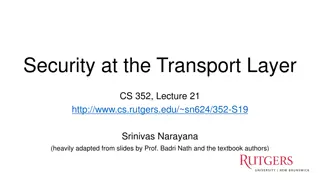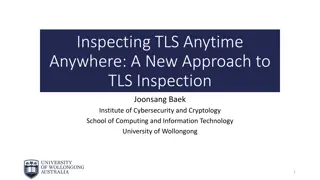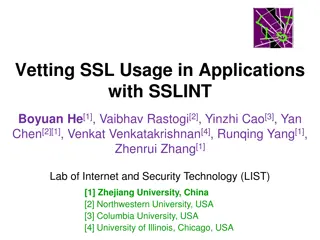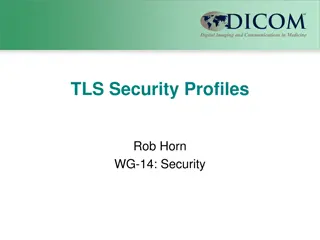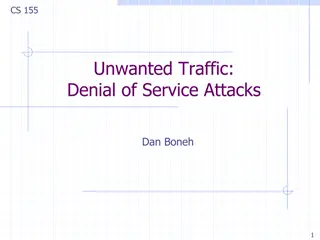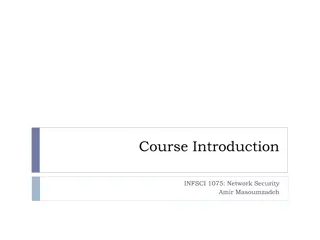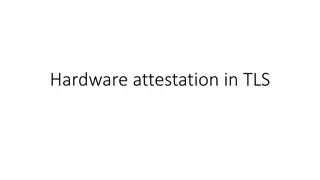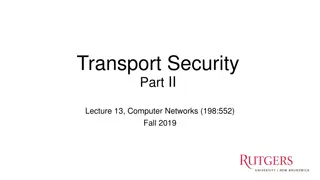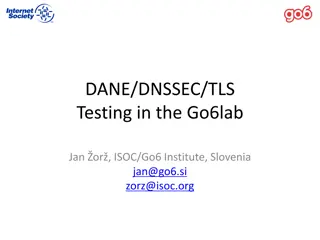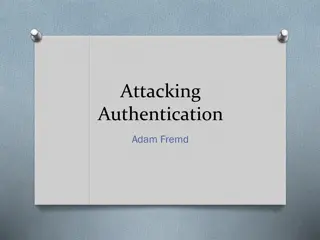Understanding TLS/SSL: Security, Attacks, and TLS 1.3
Learn about the world of TLS/SSL security, attacks, and the latest TLS 1.3 protocol. Explore how TLS ensures confidentiality and authenticity of communications, the client-server scenario in online shopping, a bit of history from SSL to TLS, and insights into different TLS versions and their security features.
Download Presentation

Please find below an Image/Link to download the presentation.
The content on the website is provided AS IS for your information and personal use only. It may not be sold, licensed, or shared on other websites without obtaining consent from the author. Download presentation by click this link. If you encounter any issues during the download, it is possible that the publisher has removed the file from their server.
E N D
Presentation Transcript
THE WORLD OF TLS Security, Attacks, TLS 1.3
HTTPS:// AND FTPS:// AND. Have you done any of the following today? E-shopping: Amazon, Ebay, Audible, Checked your Email Visited a social networking site: Facebook, Twitter, Used a secure FTP Used Voice over IP Used Google Used any URL strting with https:// and a green lock Congratulations, you ve used TLS/SSL!
PART 1 ABOUT TLS/SSL
WHAT TLS DOES Main goal: Confidentiality and Authenticity of communications Privacy of data and services exchanged Your searches on Google, or even the fact that you used Google Search rather than Google mail Guarantees still work if keys are compromised (PFS) Mostly Client you Server (Service Provider) How TLS does this: Key Exchange: yields keys for SEnc and MAC Record layer: use authenticated encryption with keys to secure communication Authentication: usually only server side (eases PKI)
THE CLIENT-SERVER SCENARIO Online shopping: You go to amazon.fr You choose what you want to buy Put it in your virtual shopping cart Log in with your user name and password Pay Wait for your delivery What actually happens: You type amazon.fr in your browser Your browser negotiates a TLS connection with Amazon You get to the website on https:// for secure browsing You authenticate to amazon on a secure link
A BIT OF HISTORY Started out as Secure Socket Layer (SSL) Developed by Netscape around 1995 Main goal: secure communication over the Internet Changed to Transport Layer Security (TLS) in 1999 Secure communication over the Internet: https but also: secure file sharing (ftp), secure emailing etc. Heavily standardised Some implementations: OpenSSL BoringSSL, mbedTLS s2n: TLS by Amazon
BIT OF A BLACK SHEEP SSL 1.0: never released (too insecure for release) SSL 2.0: released in Feb. 1995 contained a number of security flaws SSL 3.0: released in 1996, complete re-design from 2.0 TLS 1.0: no dramatic changes , but more secure backward compatible: can relax to SSL 3.0 TLS 1.1: some protection against CBC-mode attacks: explicit IV, better padding TLS 1.2: 1996 first collusion attacks on MD5; 2005: certificate forging; 2008: finally, TLS changes to SHA 1 and SHA-256; also adds AES-GCM
STRUCTURE OF TLS/SSL (UNILATERAL AUTH.) Key exchange Record layer SEnc & MAC Intuition: If keys are good , then they should secure Record layer Q1: What is a good key? Q2: How do we encrypt and authenticate?
THE TLS (1.2) HANDSHAKE (AKE) Pick ?? Pick ??? Pick ??,??? ?? ??,Cert(???),??? check Cert(???) Compute ??? ??? ??? (???; ??|??) ??|?? ??? (???; ) ???? ??? ???;1 ?) Compute ???,??? Compute ??|?? check ???? ???,< ????>?? < ????>?? check ???? ???? ??? ???;2 ?)
THE THREE MODES TLS-RSA (most used): Pick ?? Pick ??? Pick ??,??? ?? ??,Cert(???),??? check Cert(???) Choose ??? ?{0,1}8 48 RSA public encryption key ??? ??????(???) ??? Decrypt with sk
THE THREE MODES TLS-DH (second best): Pick ?? Pick ??? Pick ??,??? ?? ??,Cert(???),??? check Cert(???) Choose ??? ?{0, ? 1} ???= ????(mod ?) DH public key ???= ????(mod ?) ??? Set ??? = ??????(mod ?) ??? = ??????(mod ?)
THE THREE MODES TLS-DHE (ephemeral DH): Pick ?? Pick ??? Pick ??,??? ?? ??,Cert(???),??? check Cert(???) Fresh DH public key and matching group Choose ??? ?{0, ? 1} ???= ????(mod ?) ??? Set ??? = ??????(mod ?) ??? = ??????(mod ?)
KEY DERIVATION AND RENEGOTIATION Runs of TLS are sessions and have session IDs If client has seen server before, reuse key material (???) Use ??? instead of ??and ?? ??? ???,< ????>?? < ????>??
SUMMARY: SOME CHARACTERISTICS OF TLS Session freshness Nonces ??,??involved in key derivation ??? ??? (???; ??|??) Prevent replay attacks (that enforce same keys) Ensure forward secrecy, since they are ephemeral Server authentication Certificate ensures only server shares key with client Unilateral: anyone can exchange keys with server Key confirmation Finished messages: authenticated encryption with session keys, of a fixed message Both parties are sure they computed the same keys
PART 2 PROVABLE SECURITY AND ATTACKS
WHAT IS A GOOD KEY? Bellare-Rogaway security for key exchange: Real or Random keys Test
WHY BR SECURITY DOES NOT WORK Problem: the Finished messages When the adversary gets the keys, she can test Real/Randomness by simulating Finished messages If the key is confirmed, it s real; else, it s random Does this mean TLS is insecure? No, it means we could not prove it secure for many years Breakthrough a few years ago Krawczyk, Paterson, Wee (2013): TLS 1.2 is secure Bhargavan et al. (2014): TLS 1.2 is secure even with session resumption and changing ciphersuites Kohlweiss et al. (2014): TLS 1.2 is secure even in composition with other protocols
RECORD-LAYER SECURITY Cipher Suites: Chosen by client when sending nonce Define: key-exchange, sym. encryption, MAC, PRF Choice of block or stream ciphers, hash functions, etc. Provable security: If you have good keys, IND-CPA-secure authenticated encryption, then this creates a secure channel Problem 1: we don t really know which cipher suites are IND-CPA secure Problem 2: security models feature single-block msgs; real world msgs are multi-block and padded
PROBLEMS WITH CBC-MODE Why we like CBC mode: Efficient in practice: can decrypt a lot in constant memory and linear time Just as good as ECB for efficiency, better security Some limits: Problems with choice of IV CBC-MAC has problems with unforgeability More serious: attack by Vaudenay
VAUDENAYS ATTACK Works for specific kind of padding: Consider block length ? in bytes Message ? that has length (in bytes) not a multiple of ? Pad with ? bytes, each equal to ? : 1, 22, 333, etc. Padded message: [?1, ,??], each ??a full block Encrypt: ?1= ? ?? ??? ??; and ??= ?(?? 1??? ??) Uses error messages as oracles: If padding is incorrect, receiving party usually complains Change ciphertext ? and watch if padding still ok
BASIC ATTACK First step: find last word of ? Why this works: If ? ? ? = 1 then padding checks for decrypted ciphertext Which means, padding is correct for ? 1? ??? ? Repeat to get last block of ? , then to get ?
ERRORS THAT KILL (OPENSSH) Encrypt-then-MAC is bad: Albrecht et al. Sequence number Packet length Padding length Payload Padding Encrypt MAC Ciphertext MAC
PLAINTEXT RECOVERY Idea: Forget about the length being a length field Imagine you wanted to decrypt a ciphertext Start with one block of this ciphertext (which you want to decrypt), and send it as the first part of a new ciphertext Wait and see If no termination, then the packet passed the length check We learn 14 bits of plaintext Repeat this to get 32 bits, then more
HISTORY OF TLS ATTACKS Renegotiation attack vs >SSL 3.0: plaintext injection Ideal Patch: kill renegotiation/generate more entropy Real Patch: include previous session history Version rollback attacks: use older, weaker version/cipher Ideal Patch: kill backward compatibility/weak ciphers Real Patch: ??? (not an important/realistic attack) BEAST: browser exploits of CBC vulnerabilities Ideal Patch: kill CBC mode/ kill < TLS 1.2 Real Patch: fixed in TLS 1.1, but even if client has TLS >1.1, weak servers can force it to TLS 1.0. Extra Patch: discouraged CBC mode encouraged RC4
MORE ATTACKS ON TLS CRIME/BREACH: exploit compression characteristics Ideal Patch: kill data compression Real Patch: can kill some compression in TLS/SPDY headers; cannot kill HTTP compression (against BREACH) Timing attacks/Lucky 13: exploit padding problems Ideal Patch: kill CBC mode Real Patch: encourage RC4 instead of CBC mode TLS 1.2 does offer one good ciphersuite: AES-GCM POODLE: downgrade to SSL 3.0 and exploit away Ideal Patch: kill backward compatibility Real Patch: close our eyes and hope it goes away?
AND EVEN MORE ATTACKS RC4 attacks: RC4 output biased NOT pseudorandom Attack specifics: 2014 use many encryptions (234) and lots of generated traffic to do something la BREACH/CRIME (on cookies) 2015 use less encryptions (226) on pass- words with100 tries before lockout. Password recovery rate: 50% for pw- length 6 for BasicAuth (Chrome) Ideal Patch: kill RC4 Real Patch: RFC 7465 prohibits RC4 cipher suites. Real Deployment: 30% of SSL/TLS traffic still uses RC41 74.5% of sites allow RC4 negotiation2 few sites deploy TLS 1.2, which means alternatives are just as bad 1ICSI Certificate Notary project; 2SSL Pulse
DOES IT EVER STOP? Heartbleed: does not affect SSL/TLS, rather OpenSSL Attack strategy: read memory of users with problematic ver- sions of OpenSSL, essentially learning their long-term data Patch: do not use OpenSSL 1.0.1. to 1.0.1f. 3Shake: S1*forces same MSK in S1* - A and S1* - S2 Attack strategy: use same PMK material in two sessions, then use session resumption (no certificates!) Ideal Patch: kill renegotiation and finite fields; use ECDHE Real Patch: not really all that much FREAK: force connection on weak parameters Ideal Patch: kill backward compatibility Real Patch: fix OpenSSL, preserve backward compatibility
THE LATEST BUG: LOGJAM Export cipher suites: date back in the 90s, feature small primes Can break DLog on those groups easily, thus forge connection
WHY LOGJAM WORKS Export ciphers still exist Originally for exporting cipher suites outside the US No longer really needed, but dormant in implementation They look innocuous, like regular DH parameters Solving DLog on 512-bit fields Usually servers use the same primes over and over again: break it once, you will know it next time Generally takes longer than usual timeout of sessions but we can feed the server nonsense messages to make it wait longer Bhargavan et al.: 70 seconds to break DLog
BUT WASNT TLS PROVABLY SECURE? Security statement equivalent to: In the ROM (or with weird assumptions), given: A secure certification scheme (PKI) A collision-resistant hash function A PRF that is indistinguishable from random A Strongly-unforgeable HMAC Either CBC-mode block cipher that is a super PRP; or a stream cipher with PR output Then: TLS-RSA, TLS-DH, TLS-DHE secure How does that fit in with attacks?
GAP MODEL/REALITY De-facto security model: 1 server, perfect protocol implementation: Rules out 3Shake, Heartbleed, Padding attacks Rules out cookie problems: BREACH/CRIME Does not capture changing ciphersuites/renegotiation Rules out FREAK, renegotiation, version rollback Reductions Assuming CBC-mode block cipher that is a super PRP which is not true for TLS Assuming stream cipher with PR output DEFINITELY not true for RC 4 Close the gap or change the protocol
PART 3 TLS 1.3
TLS 1.3 (BASIC) TLS 1.2 TLS 1.3 Client Server* Client* Server CHello CHello CHshake SHello Get PMK, keys (DHE) {Scert}MS SFinished SCert SHshake Get PMK, keys SHello Get PMK, keys (RSA, DH, DHE) SHshake Check Get PMK, keys CHshake CFinished Check CFinished Check SFinished Check
KEY DERIVATION TLS 1.2 TLS 1.3 CHshake SHshake CHshake SHshake SCert SCert HKDF.Extract PM K ??? = ??? HKDF.Expand PRFPMK(nonces) MS K mES htk mSS fsk PRFMSK(nonces) HKDF.Extract Session keys MS K
MORE FEATURES OF TLS 1.3 Multiple operating modes If the client wants to resume sessions: 0 RTT If the client knows the server s PK: different resumption Full operation mode present too Restricted cipher suites: no RC4, no CBC, no RSA Independence of htk,fsk,msk: Better provable security Session hash used in key derivation: Better freshness Better security
WHAT WE HAVE AND WHAT WE WANT Desired Changes Actual Changes Kill backward compatibility Advertised for TLS 1.3 Done; de-facto is AEAD Kill CBC mode Kill RC4 Kill renegotiation Done Modified it; unclear consequences Kill finite fields (keep EC) Kill RSA mode Kill data compression Done Under consideration Partial
PERSPECTIVES TLS 1.3 far from standardisation, even farther from deployment Reluctance to learn from our mistakes: MD5 debacle; replacement only years after complete breakdown TLS 1.2: reluctance to adopt it, accept old versions Even in TLS 1.3, problematic points: renegotiation, circularities Limited security proofs for cipher suites Model limitations: still no accounting for changing cipher suites limited leakage resilience and implementations 1-server scenario


